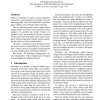Free Online Productivity Tools
i2Speak
i2Symbol
i2OCR
iTex2Img
iWeb2Print
iWeb2Shot
i2Type
iPdf2Split
iPdf2Merge
i2Bopomofo
i2Arabic
i2Style
i2Image
i2PDF
iLatex2Rtf
Sci2ools
VMV
2001
2001
Fully-Automatic Branch Labelling of Voxel Vessel Structures
Today, it is possible to acquire volume representations of the vessel structures in the brain. The selfadjusting probe, a new tool introduced in a previous paper, enables semi-automatic shape extraction. The self-adjusting probe extracts shapes from a surface model. Yet, if two vessel branches are close together, it is possible that surface vertices of a neighbor vessel are included in the set of vertices used to extract the local shape of the vessel investigated. These erroneously included vertices deteriorate the accuracy of the estimated shape. Therefore, a method has been developed to give the vessel vertices a unique label per vessel branch. Now, surface vertices of neighbor vessel branches can be excluded because their label is different. Key Words: 3D Rotational Angiography; volume visualization; Virtual Angioscopy; Computer Assisted Diagnosis; Shape Extraction.
| Added | 31 Oct 2010 |
| Updated | 31 Oct 2010 |
| Type | Conference |
| Year | 2001 |
| Where | VMV |
| Authors | Jan Bruijns |
Comments (0)

